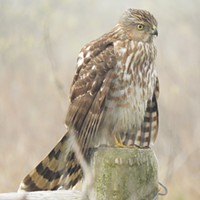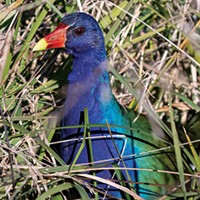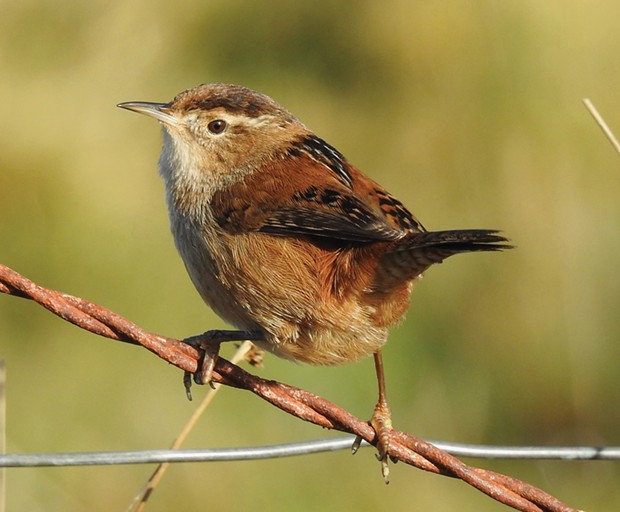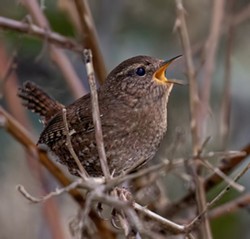[
{
"name": "Top Stories Video Pair",
"insertPoint": "7",
"component": "17087298",
"parentWrapperClass": "fdn-ads-inline-content-block",
"requiredCountToDisplay": "1"
}
]
One of the prettiest places that my dog and I like to explore is the lower section of the Arcata Ridge Trail where it follows Janes Creek. Even though it's not far from the industries that line West End Road, it feels remote, unspoiled and serene.
But not quiet. Today the Pacific wrens were bursting out in song from all directions. These tiny wrens pack a wallop into every verse, announcing spring with sweet trills and liquid warbles that seem to tumble on forever. We never saw one today, though we sometimes do, darting across the path or peeking out between leaves to look us over. It's hard to believe such a small bird is behind that spring symphony.
Humboldt County is home to a handful of wrens, a family of quirky and active songbirds that come in varying shades of brown. Each species has a unique range of vocalizations, from buzzy riffs to rich gargles to full-on orchestrations. If that's what you hear, look around for a small, long-billed brown bird with some dark barring, a distinctive forward-leaning posture and a jaunty cocked tail.
The Pacific wren favors damp forests and woodsy neighborhoods. It's a busy little bird, scurrying around the understory to feed on insects and other goodies. If you manage to catch a glimpse of one, you'll notice it's mostly dark brown all over with some barring on the flanks, its tail held upright like a banner. Its long, slightly downcurved bill is ideal for picking bugs and mites out of rotten logs.
The Arcata Marsh is a good place to encounter our other common local wren, the Marsh wren. It's a tad bigger than a Pacific wren, with a longer tail and bill and a bold white eyeline. Its brown color is rustier and it's pale underneath, with a dark triangle of feathers streaked in white on its back. The Marsh wren is a singer, too, perhaps not as melodious as the Pacific with its series of trills, rattles and squeaks, but it puts a lot of verve into the delivery. And it likes an audience; you might catch one belting out its song from the top of a cattail or fencepost. As its name implies, Marsh wrens are often found near water but can also be seen on fences and in brambles along the road where conditions are damp.
The Bewick's wren, though fairly common in Humboldt, can be a bit harder to find. Blue Lake is a good place to look; often a Bewick's can be heard singing from the deciduous woods along the Mad River levy, its song another composition of sharp trills and rusty warbles. A bit farther inland where the habitat transitions to dry scrub is also good Bewick's territory. It's a medium-sized wren with the typical long tail and bill, but is plain gray-brown on its cap and back, with more subtle barring on the tail and wings. The best field mark is its bold white eyeline — if you manage to come face to face with one, that is.
That leaves a few of the less common wrens that might take a bit more effort to find. The House wren has a wide range across the U.S., but finding one locally is sometimes a happy accident. If you stumble on a sparrow-sized, plain brown wren with a pale face lacking any eyeline, you might just be looking at a House wren. These wrens are known for adapting to suburbia, so shrubs and brambles near human habitation are pretty good places to seek one out. They have a diverse playlist of vocalizations, from rattling calls to rollicking courtship tunes as they compete for nesting territory.
One of these days, I'm hoping to add a Rock wren to my life list but, so far, this buffy, delicately barred inhabitant of dry rocky terrain has eluded me. There are a few places in Humboldt where Rock wrens can be found consistently, though, hopping around rock piles and singing songs with dozens of variations. Occasionally one will wander from its preferred inland range to the coast and bring birders out in flocks. One such bird was found at the North Jetty a few years back and I took a chance on its remaining there just one more day. That hardly ever pays off in birding and it didn't then.
Scarcer still is the Canyon wren, with only 23 eBird records in Humboldt County. A Canyon wren is like a Rock wren with a little more pizazz: richer cinnamon-y brown with black and white speckles and a bright white throat patch. A Canyon wren has specially-adapted vertebrae that allow it to reach into tight rock crevices for tiny insects — pretty cool! This would be a great bird to find up in the mountains off State Route 299, its sweetly whistled song echoing around rocky canyons and cliffs.
There's a wren (or two, or three) for nearly all our local habitats, so if a beautiful spring melody catches your ear, it might be the perfect time to test out the free bird song identification app Merlin. It's a great tool for birders of all levels.
But if the ID is secondary and you're just a sucker for a good love song, the Humboldt wrens have got you covered.
Sarah Hobart (she/her) is a freelance writer based in Humboldt County.
Speaking of...
-

Bird Names for Everyone
Feb 29, 2024 -

Spark Birds
Jan 11, 2024 -

Censored Stories, AI Moguls and Visiting Birds
Dec 8, 2023 - More »
more from the author
-
Bird Names for Everyone
- Feb 29, 2024
-
Spark Birds
- Jan 11, 2024
-
Birding Facts and Myths
- Dec 7, 2023
- More »
Latest in Get Out
Readers also liked…
-
A Walk Among the Spotted Owls
- Apr 27, 2023

































